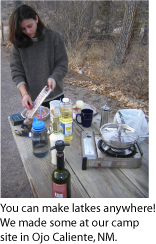Latke Advice
Though I have been expressly forbidden from owning a deep fat fryer, I get a pass this time of year, and latke duty falls upon my shoulders for whatever Hanukkah needs might arise. Over the past few years, I've gotten a little better at it and learned from a few mistakes... I'm often asked for "my recipe", and I thought I'd share it with you.
I hate to disappoint you, but "my recipe" really isn't any different from any out there. In fact there's no recipe, it's mostly done by guesswork and feel. Potato, onion, egg, salt, pepper, matzoh meal, maybe some baking powder, and that's the whole story. But instead of worrying about the quantities of ingredients, the actual preparation is the most important thing and I'll try to give you the best description. Figure four to six latkes from each medium potato:
Shred potatoes and onions, maybe one onion per two potatoes, either by hand or for larger quantities, a food processor with the shred blade. Don't worry about the potatoes discoloring. Mix them in a strainer with a generous amount of salt. The more salt, the better, basically. Here's the thing: as soon as you salt the potatoes and onions (or any vegetable, really), water will be pulled out and the mix will seem "watered down". For that reason, I place the mix in a strainer and the strainer in the sink. After 30 minutes or so, water will have dripped out of the mix and will make it easier to form latkes. Now, transfer the potato/onion mix to a mixing bowl, add one egg per potato or two, more salt (much of the earlier salt has dripped away), pepper, and matzoh meal or flour. Maybe some baking powder. Make a nice stiff mixture.
Now prepare your station. Heat some oil in a heavy pan, at least a half inch deep. Preheat your oven to 180 or 200 degrees and place a pan inside to hold finished latkes. On your counter, set up a wire rack inside a cookie sheet to drain the latkes after they come out of oil. Do NOT place them onto paper towels, as most recipes suggest, to sop up the oil. That's like an oily wet diaper for latkes, and is no bueno. Bring out the mix and an empty bowl for catching excess water as you squish and form the latkes.
The oil should be almost too hot, smoking, BECAUSE you're about to introduce a lot of cold product into it. Keep the heat high and start forming latkes about two inches across and a half inch thick, squeezing excess water into that empty bowl. Place them in the pan and let them go until they are brown and crispy on one side, then flip them. It shouldn't take too long if your oil is hot enough. Like I said, keep the flame high and be bold.
Use tongs to place the completed latkes on the wire rack and get your next batch into the oil. If you're doing a lot, each batch of latkes will soak up oil and you'll need to replenish it (and bring it back up to temp) to make sure it's deep enough. Once you've got your next batch in the pan, you can move the drained latkes from the rack to the pan in the oven. NEVER cover the pan in the oven, even if you're transporting them to another location, because they will soften and you'll lose all that crispy goodness that you worked so hard to achieve. You can hold them in the oven at a low temp for hours and they'll stay really nice.
Now go take a shower and take your window drapes to the dry cleaners. Everything in your life now smells like latkes. I forgot to tell you... you might consider doing this outside. Serve with sour cream and apple sauce. The reason the latkes should be so salty is precisely because their flavors are balanced with these two condiments.

